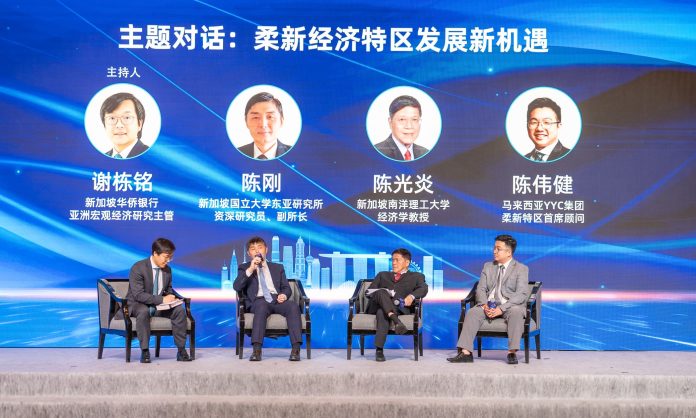On 30th December 2024, I was invited to attend the 5th China-Singapore Economic and Trade Cooperation Forum, hosted by the China Enterprises Association (Singapore) at the Shangri-La Hotel in Singapore. Notably, the association has surpassed 1,000 members in 2024, demonstrating the increasing influence of Chinese enterprises in Singapore.
The forum was moderated by Xie DongMing, Head of Asia Macro Research at OCBC Bank, with distinguished panelists including Dr Chen Gang, Deputy Director of the East Asian Institute at the National University of Singapore; Professor Tan Kong Yam, Economics Professor at Nanyang Technological University; and Chan Wei Khjan, Lead Advisor for the Johor-Singapore Special Economic Zone at YYC Group. The discussions centred on the economic landscape in the Trump 2.0 era, the impact of China-U.S. relations on ASEAN, and the potential of the Johor-Singapore Special Economic Zone (JS-SEZ).
Trade Tensions and Regional Economic Restructuring
The panellists highlighted that since Trump is re-elected, the U.S.-China trade tensions will persist, with tariff policies likely to be reinstated. However, the probability of a full-scale 60% tariff implementation remains low. The reason is that excessive tariffs could lead to worsening inflation in the U.S., which would directly impact Trump’s domestic support base—over 50% of whom belong to the lower-middle class. Consequently, the outflow of Chinese and foreign investments from China will become a norm, and whether ASEAN can effectively absorb these investors will be a focal point of discussion in the coming years.
Strategic Timing of the Johor-Singapore Special Economic Zone
The signing of the JS-SEZ coincides with the potential inauguration of Trump’s second term and Malaysia’s ASEAN chairmanship in 2025. This convergence of events has heightened investor interest in the SEZ, particularly among Chinese enterprises. The emerging trend is to establish regional headquarters in Singapore while placing technology and production centres in the JS-SEZ, fostering a complementary development model.
Notably, Malaysia’s approach to the JS-SEZ aligns with Singapore’s economy in a complementary manner. For instance, the regulatory framework for family offices in the Forest City Financial District reflects this synergy—Singapore requires a minimum of SGD20 million for setting up a family office, whereas Malaysia’s requirement in Forest City is equivalent to RM30 million (SGD10 million). This pragmatic strategy ensures that Singapore’s industry spillover can effectively connect with JS-SEZ, injecting new vitality into the regional economy.
Challenges for Investors and Government Responses
Despite the growing interest, investors remain concerned about the complexity of establishing operations in JS-SEZ, primarily due to Malaysia’s multi-tiered government regulations. While the transition to a unity government has led to a more business-friendly attitude among policymakers and civil servants, the bureaucratic efficiency gap between Malaysia and Singapore remains significant. Investors expecting Singapore-level administrative efficiency may face substantial adjustment challenges when entering Malaysia.
Future Outlook: Key Investors in JS-SEZ
Currently, China ranks as the largest foreign investor in JS-SEZ, followed by Singapore. Given the current regional macroeconomic environment and investment trends, Chinese and Singaporean investors are expected to remain the primary sources of foreign investment in JS-SEZ over the next year. Additionally, Malaysia’s multilingual advantage will serve as a significant asset in attracting international businesses.
In summary, JS-SEZ stands at the forefront of ASEAN’s economic restructuring. The key challenge for the Malaysian government and businesses will be to optimise policies, enhance infrastructure, and improve administrative efficiency to better accommodate global industrial shifts and attract sustained investment.




